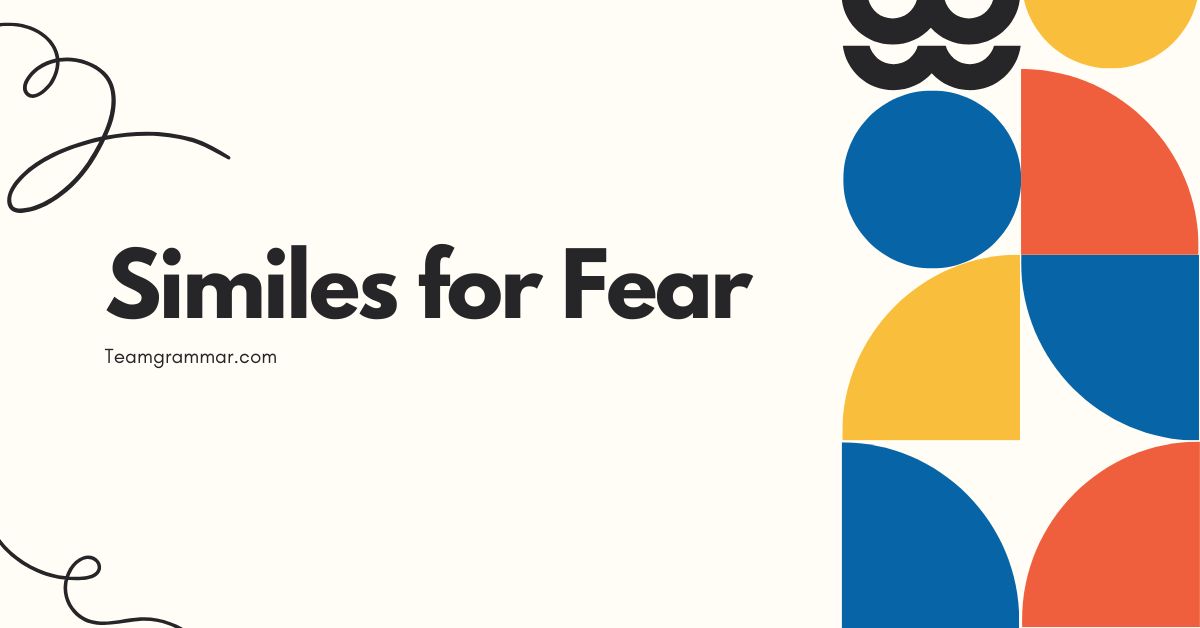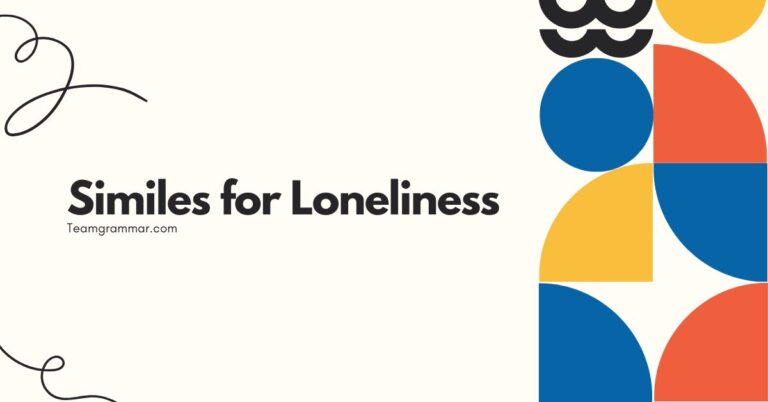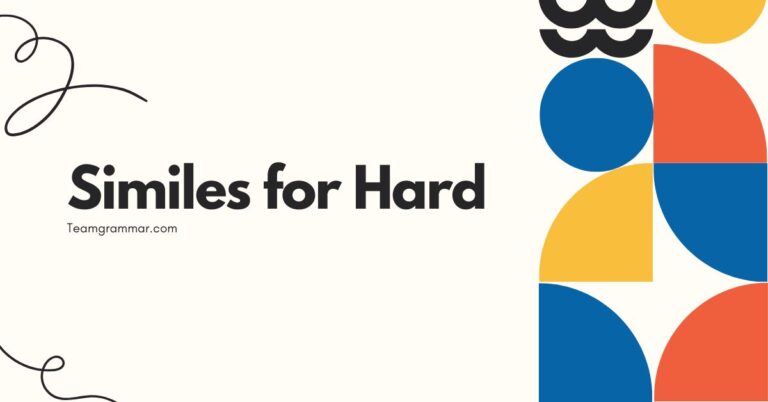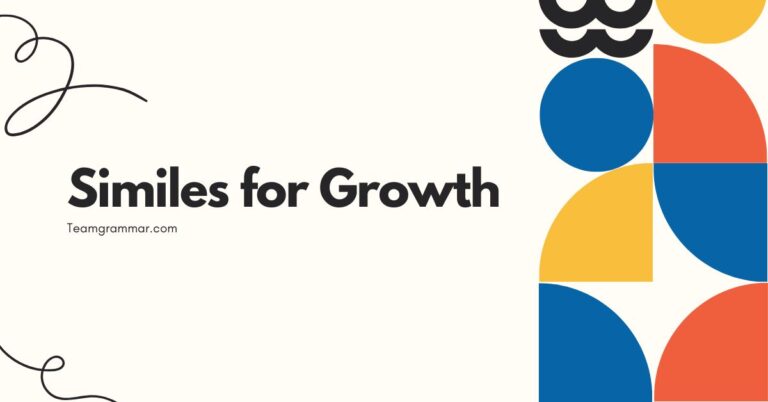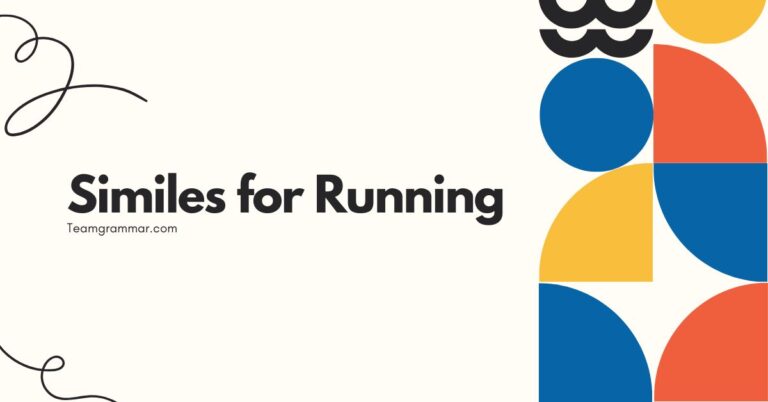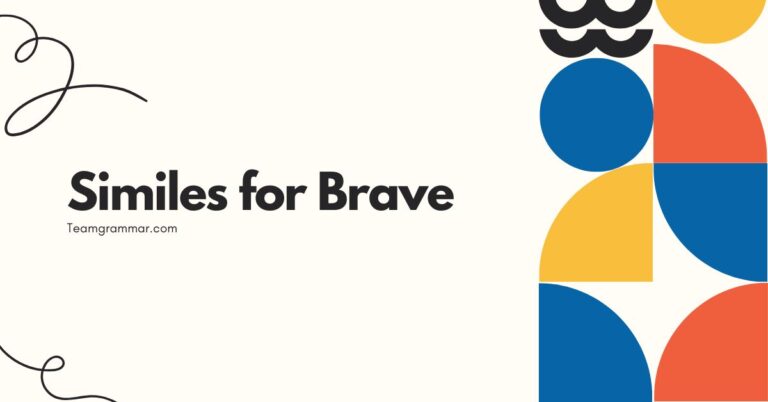39 Similes for Fear: Mastering Expressive Comparisons
Understanding how to use similes to describe fear is crucial for vivid and engaging writing. Similes allow us to compare fear to something else, making the emotion more relatable and impactful for the reader.
This article will explore various similes that capture the essence of fear, providing examples, usage rules, and practice exercises. Whether you’re a student, writer, or language enthusiast, this guide will enhance your ability to express fear effectively in your writing and speech.
Table of Contents
- Introduction
- Definition of Simile and its Relation to Fear
- Structural Breakdown of Similes for Fear
- Types of Similes for Fear
- Examples of Similes for Fear
- Usage Rules for Similes
- Common Mistakes When Using Similes for Fear
- Practice Exercises
- Advanced Topics: Nuances in Simile Usage
- Frequently Asked Questions
- Conclusion
Definition of Simile and its Relation to Fear
A simile is a figure of speech that compares two unlike things using “like” or “as.” Its primary function is to create a vivid image or convey a particular feeling by drawing a parallel between something familiar and something less so. Similes are essential tools for writers and speakers seeking to add depth and color to their descriptions.
When related to fear, similes can be incredibly effective in conveying the intensity, nature, and impact of this emotion. Fear, being a complex and often overwhelming feeling, can be difficult to describe directly.
By using similes, we can express the sensation of fear in more relatable and understandable terms. For instance, comparing fear to “ice water in one’s veins” immediately conveys a sense of chilling dread and paralysis.
The power of similes lies in their ability to evoke sensory experiences and emotional resonance. They allow the audience to connect with the feeling being described on a deeper, more personal level.
This makes similes particularly useful in storytelling, poetry, and any form of writing where emotional impact is desired. Choosing the right simile can transform a simple statement into a powerful and memorable expression of fear.
Structural Breakdown of Similes for Fear
The structure of a simile is relatively straightforward. It typically consists of three main components: the subject (the thing being described, in this case, fear), the comparative word (“like” or “as”), and the object of comparison (the thing to which fear is being compared).
Understanding this structure makes it easier to create and analyze similes effectively.
The basic formula for a simile is:Subject + Comparative Word + Object of Comparison. For example, in the simile “Fear gripped him like a vise,” “fear” is the subject, “like” is the comparative word, and “a vise” is the object of comparison.
This structure clearly shows how fear is being equated to the feeling of being squeezed tightly by a vise.
The choice of the object of comparison is crucial. It should be something that the audience can easily understand and relate to.
The more vivid and specific the object of comparison, the more effective the simile will be. For example, comparing fear to “a dark shadow” is less specific than comparing it to “a venomous snake coiling in his stomach.” The latter provides a more visceral and impactful image of fear.
While “like” and “as” are the most common comparative words, variations can add nuance. Phrases such as “similar to,” “resembles,” or “in the same way as” can also be used to create similes, although they are less common.
However, for clarity and impact, “like” and “as” usually provide the most direct and effective comparison.
Types of Similes for Fear
Similes for fear can be categorized based on the aspect of fear they emphasize. These categories include similes that describe physical manifestations of fear, mental states induced by fear, situational triggers of fear, the intensity of fear, and the subtlety of fear.
Similes Describing Physical Fear
These similes focus on the physical sensations associated with fear, such as trembling, sweating, rapid heartbeat, and shortness of breath. They aim to convey how fear affects the body.
Similes Describing Mental Fear
These similes highlight the psychological impact of fear, including anxiety, paranoia, confusion, and loss of control. They focus on how fear affects the mind.
Similes Describing Situational Fear
These similes connect fear to specific situations or environments, such as being in a dark alley, facing a dangerous animal, or experiencing a natural disaster. They emphasize the context in which fear arises.
Similes Describing Overwhelming Fear
These similes convey the sheer intensity and magnitude of fear, emphasizing its overwhelming and paralyzing effects. They aim to capture the feeling of being completely consumed by fear.
Similes Describing Subtle Fear
These similes depict the more nuanced and understated aspects of fear, such as apprehension, unease, and a sense of foreboding. They focus on the quieter, more insidious forms of fear.
Examples of Similes for Fear
Here are numerous examples of similes for fear, organized by category, to illustrate the diverse ways this emotion can be expressed through comparison.
Similes Describing Physical Fear
These similes highlight the body’s reactions to fear, such as trembling, sweating, and a racing heart. They bring the physical experience of fear to life for the reader.
Here is a table with examples of similes describing physical fear:
| Simile | Explanation |
|---|---|
| His hands trembled like leaves in a storm. | Describes uncontrollable shaking due to fear. |
| Her heart pounded like a drum solo. | Illustrates a racing heartbeat from anxiety. |
| He was as pale as a ghost. | Conveys extreme pallor due to shock and fear. |
| Sweat poured down his face like a waterfall. | Emphasizes profuse sweating caused by fear. |
| His breath came in gasps, like a fish out of water. | Describes difficulty breathing due to panic. |
| Her legs felt like jelly. | Indicates weakness and instability from fear. |
| His stomach churned like a washing machine. | Conveys nausea and unease caused by fear. |
| His skin prickled as if a thousand ants were crawling on it. | Describes the sensation of goosebumps from fear. |
| His voice cracked like thin ice. | Illustrates how fear can affect vocal control. |
| He felt as cold as a corpse. | Describes a chilling sensation caused by fear. |
| Her teeth chattered like castanets. | Highlights shivering due to fear. |
| He froze like a statue. | Illustrates paralysis caused by fear. |
| His muscles were as tight as coiled springs. | Conveys tension and rigidity from fear. |
| His vision blurred like looking through frosted glass. | Describes visual impairment due to fear. |
| He felt lightheaded, like he might faint. | Indicates dizziness and potential loss of consciousness. |
| His throat was as dry as the desert. | Describes dehydration and difficulty swallowing due to fear. |
| His hands were clammy like a cold fish. | Highlights the sensation of sweaty, cold hands. |
| His head throbbed like a drum. | Conveys a pounding headache induced by fear. |
| His body was as tense as a drawn bow. | Illustrates extreme physical tension. |
| He jumped like a startled cat. | Describes a sudden, involuntary reaction to fear. |
| His blood ran cold like ice water. | Describes the feeling of chilling dread. |
| His knees knocked together like drumsticks. | Illustrates uncontrollable shaking of the legs. |
Similes Describing Mental Fear
These similes focus on the psychological effects of fear, such as anxiety, paranoia, and confusion. They delve into the mental state of someone experiencing fear.
Here is a table with examples of similes describing mental fear:
| Simile | Explanation |
|---|---|
| His mind raced like a runaway train. | Describes uncontrolled and rapid thoughts. |
| He felt as lost as a child in a crowded city. | Conveys a sense of disorientation and helplessness. |
| Doubt gnawed at him like a rat. | Illustrates persistent and destructive anxiety. |
| His thoughts were as tangled as a ball of yarn. | Describes confusion and lack of clarity. |
| He felt as if his mind was a blank slate. | Conveys a sense of mental emptiness and shock. |
| Paranoia crept into his mind like a vine. | Illustrates the gradual and insidious growth of suspicion. |
| His memories were as fragmented as shattered glass. | Describes the disorienting effect of trauma on memory. |
| He felt like he was trapped in a nightmare. | Conveys a sense of inescapable dread and horror. |
| His thoughts echoed in his head like whispers in a tomb. | Illustrates persistent and haunting thoughts. |
| He felt as if his sanity was slipping away like sand through his fingers. | Describes a gradual loss of mental stability. |
| His fear was a heavy cloak weighing him down. | Illustrates the burden of anxiety and dread. |
| His mind was a battlefield of conflicting thoughts. | Conveys internal conflict and turmoil. |
| He felt as vulnerable as a lamb among wolves. | Describes a sense of defenselessness and danger. |
| His anxiety was a persistent hum in the background of his mind. | Illustrates constant and nagging worry. |
| He felt like he was walking on eggshells. | Conveys a sense of extreme caution and unease. |
| His fear was a dark cloud obscuring his judgment. | Describes how fear can impair rational thinking. |
| He felt as exposed as a tree struck by lightning. | Illustrates vulnerability and imminent danger. |
| His thoughts were as chaotic as a hurricane. | Conveys overwhelming mental disarray. |
| He felt like he was drowning in a sea of anxiety. | Describes the feeling of being overwhelmed by worry. |
| His fear was a cold hand gripping his heart. | Illustrates a chilling and oppressive feeling. |
| His courage crumbled like a sandcastle before the tide. | Describes a sudden loss of bravery. |
| He felt as transparent as glass, with his fear on full display. | Illustrates a lack of ability to hide his fear. |
Similes Describing Situational Fear
These similes link fear to specific situations or environments, highlighting how external factors can trigger feelings of fear. They emphasize the context in which fear arises.
Here is a table with examples of similes describing situational fear:
| Simile | Explanation |
|---|---|
| Walking through the dark forest felt like entering a monster’s lair. | Conveys a sense of danger and foreboding. |
| Being alone in the abandoned house was like stepping into a ghost story. | Illustrates the eerie and unsettling nature of the situation. |
| The silence in the room was as thick as a shroud. | Describes an oppressive and ominous atmosphere. |
| The storm raged outside like the end of the world. | Conveys a sense of impending doom and chaos. |
| Facing the angry mob was like standing before a firing squad. | Illustrates a sense of imminent threat and danger. |
| The empty streets felt like a scene from a post-apocalyptic movie. | Describes desolation and a sense of unease. |
| The creaking of the old house was like the whispers of ghosts. | Conveys a haunting and supernatural atmosphere. |
| Being lost in the maze felt like being trapped in a nightmare. | Illustrates disorientation and a sense of inescapable fear. |
| The dark alleyway was as inviting as a viper’s nest. | Conveys a sense of danger and hostility. |
| Watching the approaching tornado was like witnessing the wrath of God. | Describes awe and terror in the face of overwhelming power. |
| The interrogation room felt like a pressure cooker. | Illustrates intense stress and confinement. |
| The haunted house was like a magnet for fear. | Conveys the house’s ability to attract and amplify fear. |
| The deserted island felt like the edge of the world. | Describes isolation and a sense of vulnerability. |
| The crowded stadium before the game felt like a cauldron about to boil over. | Illustrates tension and potential for chaos. |
| The deep ocean trench was like a gateway to another world, filled with unknown terrors. | Conveys mystery and potential danger. |
| The abandoned hospital was like a tomb filled with forgotten suffering. | Describes a place of lingering pain and sorrow. |
| Navigating the bureaucratic system felt like wandering through a labyrinth. | Illustrates frustration and a sense of being lost. |
| The vast, empty desert felt like a desolate wasteland. | Conveys isolation and a lack of hope. |
| The dimly lit carnival at night was like a twisted funhouse mirror reflecting hidden fears. | Describes an unsettling and distorted atmosphere. |
| The courtroom during the verdict felt like a stage for destiny. | Illustrates a moment of intense anticipation and potential consequences. |
| The rickety bridge swayed like a thread over an abyss. | Describes a precarious and dangerous situation. |
| The old graveyard at midnight was as welcoming as the gates of hell. | Conveys a sense of dread and the macabre. |
Similes Describing Overwhelming Fear
These similes convey the sheer intensity and magnitude of fear, emphasizing its paralyzing and consuming effects. They capture the feeling of being completely overcome by fear.
Here is a table with examples of similes describing overwhelming fear:
| Simile | Explanation |
|---|---|
| Fear washed over him like a tidal wave. | Conveys an overwhelming and unstoppable force. |
| He was paralyzed by fear, like a deer caught in headlights. | Illustrates a state of complete immobility due to fear. |
| The terror consumed him like a wildfire. | Describes rapid and destructive spreading of fear. |
| He felt as if he was drowning in a sea of fear. | Conveys a sense of being overwhelmed and suffocated. |
| His fear was a black hole, sucking all the light and hope from his soul. | Illustrates a sense of complete despair and emptiness. |
| The panic rose in him like a volcano erupting. | Describes a sudden and explosive surge of fear. |
| He was frozen with fear, like a statue in a blizzard. | Conveys a sense of complete and unrelenting coldness and immobility. |
| His fear was a monster, devouring him from the inside out. | Illustrates a destructive and consuming force. |
| The terror gripped him like a vise, squeezing the life out of him. | Conveys a sense of intense pressure and suffocation. |
| He felt as if the world was collapsing around him, crushing him with fear. | Describes a sense of impending doom and destruction. |
| Fear enveloped him like a suffocating blanket. | Illustrates a sense of being trapped and unable to breathe. |
| His terror was an abyss, pulling him into its depths. | Conveys a sense of falling into endless darkness. |
| He felt as though his soul was being ripped apart by fear. | Describes intense emotional pain and suffering. |
| His fear was an avalanche, burying him under its weight. | Conveys being overwhelmed by a massive force. |
| He was as helpless as a leaf caught in a hurricane. | Illustrates a complete lack of control and vulnerability. |
| His fear was a poison, spreading through every vein. | Describes the insidious and destructive nature of fear. |
| He felt as if he was being torn apart by invisible forces. | Conveys a sense of intense inner turmoil. |
| His fear was a storm, raging within him and threatening to destroy everything. | Illustrates internal chaos and potential for destruction. |
| He was as vulnerable as a newborn babe exposed to the elements. | Describes extreme defenselessness and susceptibility. |
| His fear was a living entity, feeding on his sanity. | Conveys a sense of being consumed by an external force. |
Similes Describing Subtle Fear
These similes capture the more nuanced and understated aspects of fear, such as apprehension, unease, and a sense of foreboding. They focus on the quieter, more insidious forms of fear.
Here is a table with examples of similes describing subtle fear:
| Simile | Explanation |
|---|---|
| A sense of unease settled over him like a thin layer of frost. | Conveys a delicate but pervasive feeling of discomfort. |
| He felt a prickle of fear, like the first touch of a spider’s web. | Illustrates a subtle and unsettling sensation. |
| The silence was as heavy as a held breath. | Describes a tense and expectant atmosphere. |
| A shadow of doubt lingered in his mind like a faint stain. | Conveys a persistent but understated sense of uncertainty. |
| He felt a chill in the air, like the presence of something unseen. | Illustrates a subtle sense of unease and foreboding. |
| The anticipation hung in the air like a spiderweb, waiting to ensnare him. | Conveys a sense of impending danger and entrapment. |
| He felt a knot of anxiety tightening in his stomach like a slow-growing tumor. | Describes a gradual and insidious increase in worry. |
| The room felt as still as a tomb, filled with unspoken dread. | Conveys a sense of quiet and ominous anticipation. |
| A sense of foreboding crept over him like a gathering storm. | Illustrates a gradual and ominous build-up of apprehension. |
| He felt a shiver run down his spine like a ghost’s touch. | Conveys a subtle but unsettling physical sensation. |
| His intuition whispered warnings like a distant echo. | Illustrates subtle and understated premonitions. |
| He sensed danger lurking just beyond the edge of his perception, like a predator in the shadows. | Conveys a sense of hidden and imminent threat. |
| He felt a subtle unease, like a discordant note in a familiar melody. | Illustrates a jarring and unsettling feeling. |
| The atmosphere was charged with unspoken tension, like a wire stretched to its breaking point. | Conveys a sense of imminent release or conflict. |
| He felt as though he were walking on thin ice, unsure of where to step next. | Describes a sense of precariousness and uncertainty. |
| A subtle sense of dread settled over him like a shroud. | Illustrates a quiet but pervasive feeling of gloom. |
| He felt a prickling sensation on the back of his neck, like the eyes of someone watching him. | Conveys a subtle but unsettling sense of being observed. |
| The silence was broken only by the sound of his own heartbeat, as loud as a drum in the stillness. | Illustrates heightened awareness and anxiety. |
| He felt a sense of vulnerability, like a single tree standing alone in a vast plain. | Describes isolation and defenselessness. |
| A subtle sense of disquiet lingered in the air like the scent of smoke after a fire. | Conveys a persistent and unsettling feeling. |
Usage Rules for Similes
Using similes effectively requires understanding a few key rules. First, ensure that the comparison is clear and relevant.
The object of comparison should be something that the audience can easily understand and relate to. The more direct and obvious the connection, the more effective the simile will be.
Second, avoid clichés. Overused similes, such as “as brave as a lion” or “as quiet as a mouse,” have lost their impact and can make your writing seem unoriginal.
Strive to create fresh and imaginative comparisons that will surprise and engage your readers. Instead of saying “as scared as a mouse,” consider something more unique like “his fear was a venomous snake coiling in his stomach.”
Third, be mindful of the context. The appropriateness of a simile depends on the tone and subject matter of your writing.
A simile that works well in a horror story might be out of place in a lighthearted comedy. Consider your audience and the overall message you are trying to convey when choosing your similes.
Fourth, ensure grammatical correctness. The comparative words “like” and “as” should be used correctly to create a simile.
Avoid confusing similes with metaphors, which imply a direct equivalence rather than a comparison. For example, “He was a lion in battle” is a metaphor, while “He fought like a lion in battle” is a simile.
Finally, use similes sparingly. Overusing similes can make your writing seem forced and artificial.
The best similes are those that are used judiciously to enhance and illuminate your descriptions, adding depth and color without overwhelming the reader.
Common Mistakes When Using Similes for Fear
One common mistake is using clichés. Overused similes lack originality and fail to create a strong impact.
For example, saying “He was as scared as a ghost” is a cliché. Instead, try “His face was ashen, like a statue carved from moonlight,” which is more vivid and original.
Another mistake is creating comparisons that don’t make sense. The object of comparison should be something that the audience can easily understand and relate to.
For example, comparing fear to something obscure or abstract will likely confuse the reader. Instead of saying “His fear was like a hypercube,” try “His fear was a crushing weight, like a mountain on his chest,” which is more relatable.
Confusing similes with metaphors is also a common error. Similes use “like” or “as” to make a comparison, while metaphors imply a direct equivalence.
For example, “His fear was a monster” is a metaphor, while “His fear was like a monster in his mind” is a simile.
Overusing similes can also weaken your writing. Too many similes can make your descriptions feel forced and unnatural.
Use similes sparingly and only when they add significant value to your writing. Instead of using multiple similes in a single paragraph, focus on crafting strong, descriptive sentences that stand on their own.
Finally, grammatical errors can undermine the effectiveness of your similes. Ensure that you are using “like” and “as” correctly and that your sentences are grammatically sound.
For example, “He felt like he was going to die” is correct, while “He felt as he was going to die” is incorrect.
Here are some examples of correct vs. incorrect simile usage:
| Incorrect | Correct | Explanation |
|---|---|---|
| He was as scared as a cat. | He was as scared as a rabbit caught in headlights. | The correct example is more vivid and specific. |
| His fear was a table. | His fear was like a suffocating blanket. | The correct example creates a logical comparison. |
| She felt as she was drowning. | She felt as if she was drowning. | Correct usage of “as if”. |
| His fear, it was a monster. | His fear was like a monster in his mind. | The correct example uses “like” to create a simile. |
Practice Exercises
Test your understanding of similes for fear with these practice exercises. Identify the similes in the sentences and explain what they convey.
Then, create your own similes for the given scenarios.
Exercise 1: Identifying Similes
Identify the similes in the following sentences and explain what aspect of fear they emphasize.
| Question | Answer |
|---|---|
| 1. His hands trembled like leaves in a storm. | Simile: “like leaves in a storm.” Emphasizes the physical manifestation of fear, specifically uncontrollable shaking. |
| 2. Her heart pounded like a drum solo. | Simile: “like a drum solo.” Emphasizes the physical sensation of a racing heartbeat due to anxiety. |
| 3. Fear washed over him like a tidal wave. | Simile: “like a tidal wave.” Emphasizes the overwhelming and unstoppable nature of fear. |
| 4. He felt as lost as a child in a crowded city. | Simile: “as lost as a child in a crowded city.” Emphasizes the mental state of disorientation and helplessness. |
| 5. Walking through the dark forest felt like entering a monster’s lair. | Simile: “like entering a monster’s lair.” Emphasizes the situational fear of being in a dangerous environment. |
| 6. The silence in the room was as thick as a shroud. | Simile: “as thick as a shroud.” Emphasizes the oppressive and ominous atmosphere. |
| 7. Doubt gnawed at him like a rat. | Simile: “like a rat.” Emphasizes persistent and destructive anxiety. |
| 8. He was as pale as a ghost. | Simile: “as pale as a ghost.” Emphasizes the physical manifestation of fear, specifically extreme pallor. |
| 9. His fear was a black hole, sucking all the light and hope from his soul. | Simile: “like a black hole.” Emphasizes the overwhelming sense of despair and emptiness. |
| 10. A sense of unease settled over him like a thin layer of frost. | Simile: “like a thin layer of frost.” Emphasizes a delicate but pervasive feeling of discomfort. |
Exercise 2: Creating Similes
Create similes for the following scenarios, focusing on expressing the feeling of fear.
| Scenario | Possible Simile |
|---|---|
| 1. Being alone in a dark house. | Being alone in a dark house felt like being trapped in a horror movie. |
| 2. Facing a public speaking engagement. | Facing the audience felt like standing on the edge of a cliff, ready to jump. |
| 3. Hearing a strange noise in the middle of the night. | The strange noise was like a cold hand reaching out from the darkness. |
| 4. Watching a scary movie. | Watching the scary movie was like descending into a nightmare. |
| 5. Waiting for important test results. | Waiting for the results felt like waiting for a judge to pronounce a life sentence. |
| 6. Realizing you’re lost in an unfamiliar city. | Realizing I was lost felt like being adrift in a sea of faces and buildings. |
| 7. Discovering a large spider in your bedroom. | Discovering the spider felt like a monster had invaded my personal space. |
| 8. Experiencing turbulence on an airplane. | The turbulence felt like the plane was being tossed around by a giant. |
| 9. Walking across a rickety bridge. | Walking across the bridge felt like dancing with death. |
| 10. Encountering a bear in the woods. | Encountering the bear felt like coming face to face with primal fear itself. |
Advanced Topics: Nuances in Simile Usage
For advanced learners, understanding the nuances of simile usage can significantly enhance their writing. This includes recognizing the cultural and contextual implications of different comparisons, as well as mastering the art of creating subtle and layered similes.
Cultural context plays a crucial role in how similes are interpreted. A simile that resonates strongly in one culture may be meaningless or even offensive in another.
For example, comparing fear to “a banshee’s scream” might be effective in Irish culture, where banshees are well-known figures of folklore, but it may not have the same impact on an audience unfamiliar with Irish mythology. Consider your audience and their cultural background when choosing your similes.
Subtlety in simile usage involves crafting comparisons that are not immediately obvious but gradually reveal their meaning and impact. This can be achieved through the use of evocative language, imagery, and carefully chosen details.
For example, instead of saying “His fear was like a monster,” you might say “A shadow lingered in his eyes, growing darker with each passing moment, like a storm gathering on the horizon.” This creates a more nuanced and atmospheric sense of fear.
Layered similes involve combining multiple comparisons to create a more complex and multifaceted image. This can be achieved by using a series of related similes or by embedding one simile within another.
For example, “His fear was like a labyrinth, each twist and turn leading him deeper into the darkness, like a ship lost at sea without a compass.” This creates a richer and more immersive experience for the reader.
Experiment with different techniques and approaches to simile usage to find what works best for you. Pay attention to the language used by skilled writers and speakers, and analyze how they use similes to create vivid and memorable descriptions.
With practice and attention to detail, you can master the art of using similes to express even the most complex and subtle emotions.
Frequently Asked Questions
Here are some frequently asked questions about similes, particularly in the context of expressing fear.
- What is the difference between
a simile and a metaphor?
A simile is a comparison between two unlike things using “like” or “as,” while a metaphor implies a direct equivalence without using these words. For example, “His fear was like a monster” is a simile, while “His fear was a monster” is a metaphor.
- Why use similes to describe fear?
Similes make fear more relatable and understandable by comparing it to something familiar. They add depth and color to your writing, creating a stronger emotional impact.
- How can I avoid using clichés in my similes?
Strive to create fresh and imaginative comparisons that will surprise and engage your readers. Think about specific details and sensory experiences that can make your similes more vivid and original.
- What makes a simile effective?
An effective simile is clear, relevant, and original. It should use language that is vivid and engaging, and it should create a strong connection between the subject and the object of comparison.
- Can I use too many similes in my writing?
Yes, overusing similes can make your writing seem forced and unnatural. Use similes sparingly and only when they add significant value to your descriptions.
- How do I choose the right object of comparison for my simile?
Choose an object of comparison that is something the audience can easily understand and relate to. The more vivid and specific the object of comparison, the more effective the simile will be.
- Are some similes more appropriate for certain contexts?
Yes, the appropriateness of a simile depends on the tone and subject matter of your writing. Consider your audience and the overall message you are trying to convey when choosing your similes.
- What are some common mistakes to avoid when using similes?
Common mistakes include using clichés, creating comparisons that don’t make sense, confusing similes with metaphors, and overusing similes.
- How can I improve my simile writing skills?
Practice creating similes for different scenarios, pay attention to the language used by skilled writers and speakers, and analyze how they use similes to create vivid and memorable descriptions.
- Is it okay to use similes in formal writing?
Yes, similes can be used in formal writing, but they should be used judiciously and with careful consideration of the context and audience. Avoid overly informal or colloquial comparisons.
Conclusion
Mastering the use of similes for fear is a valuable skill for anyone looking to enhance their writing and communication. By understanding the structure, types, and usage rules of similes, you can create vivid and impactful descriptions that resonate with your audience.
Avoid common mistakes, practice regularly, and pay attention to the nuances of language to elevate your writing to new heights. Whether you are a student, writer, or language enthusiast, the ability to craft effective similes will undoubtedly enrich your expressive toolkit and allow you to convey the complex emotion of fear with greater depth and precision.

